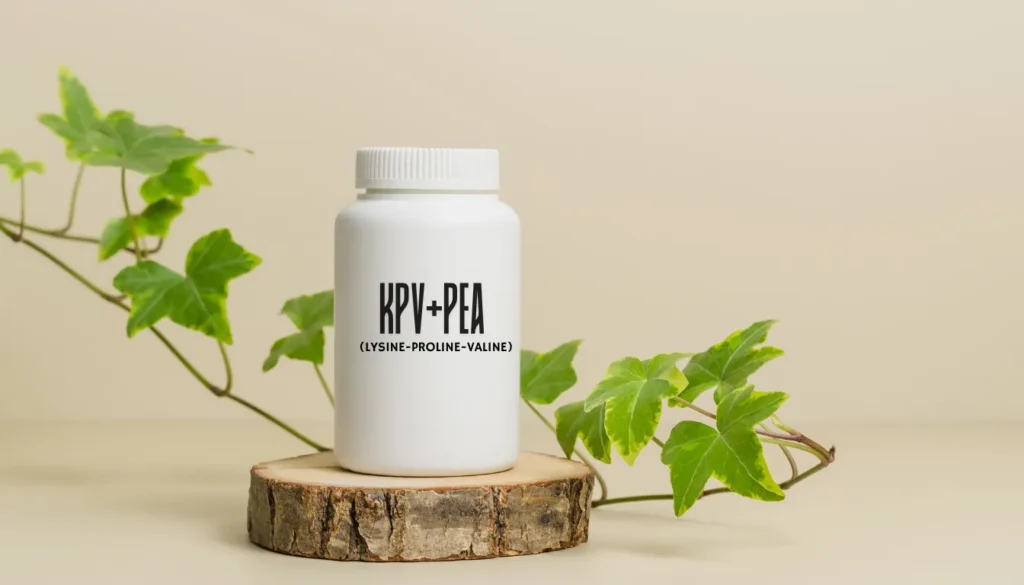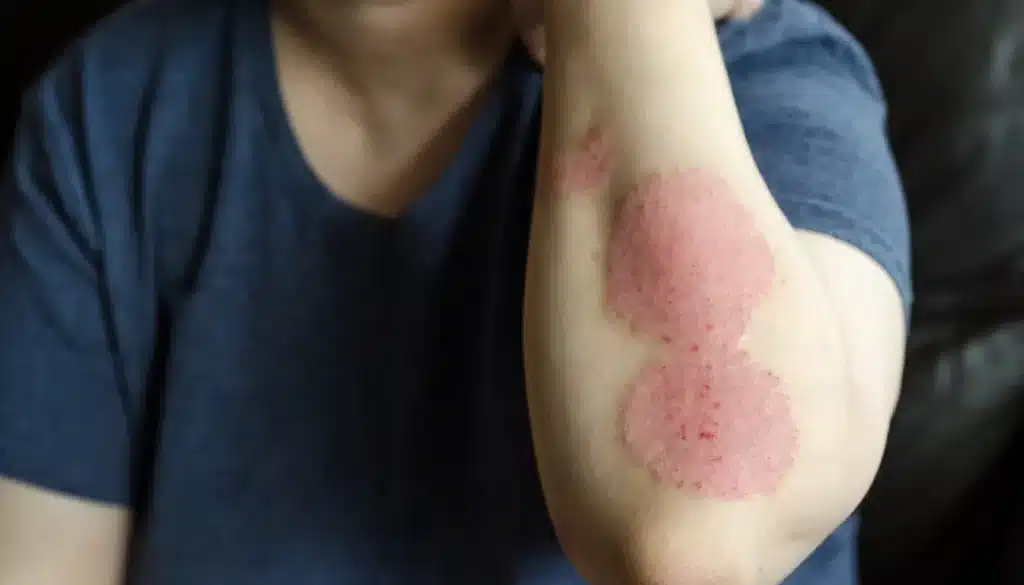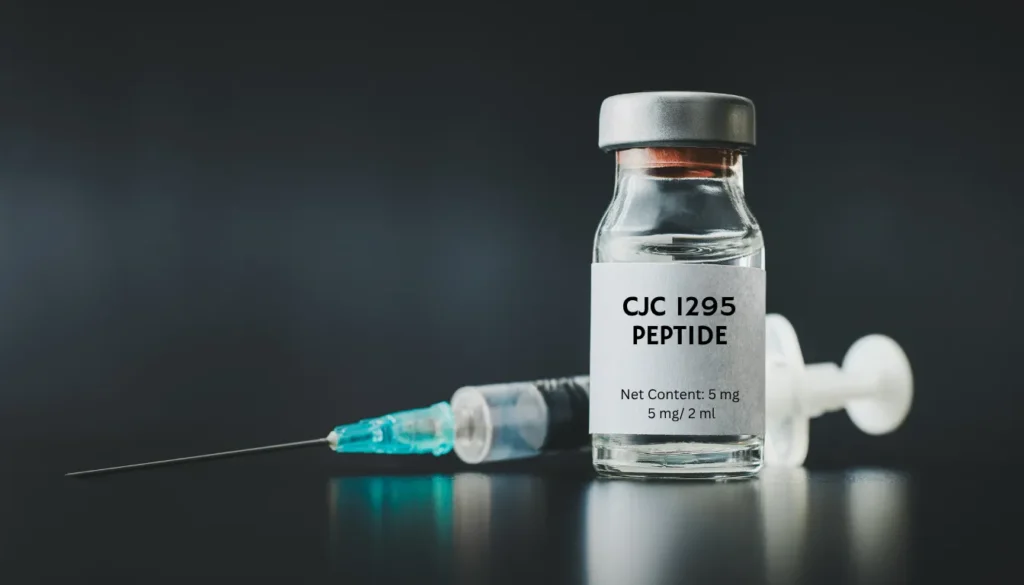
Written by Dr. Diane Mueller
When you’ve been battling Lyme disease for months or years without significant improvement, you’ve probably explored every treatment avenue imaginable, and the search for relief can feel endless. But what if there’s a therapy that has been quietly revolutionizing the treatment of chronic illnesses? Enter peptide therapy – an approach that’s catching the attention of functional medicine practitioners and patients alike.
The early results for peptide therapy for Lyme disease are promising. Throughout this article, we’ll explore how these molecular tools work, identify which peptides show the most potential for Lyme disease recovery, and provide key information to consider before adopting this innovative treatment approach.
Peptides are cellular repair tools, not cures. These amino acid chains help rebuild immune function and reduce inflammation after Lyme damage, but cannot eliminate the underlying infection and must be combined with antimicrobial treatments.
Start with KPV peptide for sensitive systems. This anti-inflammatory peptide stabilizes overactive mast cells and reduces sensitivity reactions, making it the ideal first peptide to introduce before others, such as BPC-157 or growth hormone peptides.
Source matters critically for safety and effectiveness – Only use pharmaceutical-grade peptides from licensed compounding pharmacies with proper prescriptions, as unregulated online sources often contain contaminated or ineffective products.
Address root causes before peptide therapy – Active infections, mold exposure, and environmental toxins must be eliminated first, as peptides work best when supporting comprehensive treatment plans rather than fighting ongoing triggers.
Expect results in 2-6 months for meaningful outcomes. Most patients experience initial improvements around 2-3 months, with optimal benefits requiring 6 months or more of consistent use under professional monitoring and dose adjustments.
Herxheimer reactions require careful management – Start with minimal doses and work with experienced practitioners to navigate temporary symptom flares that often indicate the therapy is working to release stored toxins
Tired of feeling like your body’s a rusty car sputtering along after a nasty tick bite? Peptide therapy might just be the oil change you’ve been craving. Here’s how these tiny but mighty molecules are changing the game when it comes to persistent Lyme disease symptoms — and why they aren’t your grandparents’ antibiotics.
Imagine your body’s healing crew is working overtime, patching up damage, dousing fires (aka inflammation), and radioing for backup when germs invade. Peptides are like their walkie-talkies—short strands of amino acids that deliver the right message at the right time.
Peptide therapy doesn’t just slap a band-aid on nagging symptoms. Peptides — like KPV, CJC-1295, and Ipamorelin — can dial down swelling, cool off angry joints, soothe frazzled nerves, and even coax your immune system back into its groove. Many folks with Lyme or mold illness notice stubborn problems like brain fog, bone-deep fatigue, and “mystery aches” hanging on even after regular meds. Peptides address these issues by supporting tissue repair and modulating intense immune reactions.
Functional medicine practitioners love peptides because they’re not just hunting the infection itself — they’re tackling root causes, looking for hidden saboteurs like immune misfires or toxic mold exposure. You could call it a detective squad for your health, working behind the scenes.
Let’s be real: If you expect a one-pill-and-done fix for Lyme, you’re probably set up for disappointment (and possibly a few eye rolls from practitioners who see the whole messy picture). Functional medicine clinics—like My Lyme Doc—dive deeper into the root causes of health issues. They know that mold, Babesia, Bartonella, and other pathogens can complicate recovery. While antibiotics target the main villain, peptides provide specialized reinforcements. They may not headline mainstream talk shows, but in the world of chronic Lyme, they’re getting a reputation for quietly helping people reclaim energy, sharper thinking, and fewer daily “ouch” moments.
So, if you’re determined to go beyond the so-called “magic bullet” approach, peptides are worth a closer look.
Here’s where the story keeps it honest: Peptides are not superhero capes that swoop in and erase Borrelia burgdorferi itself. They’re more like expert coaches—reducing inflammation, repairing tendon tears, and supporting your immune all-stars so your body’s defense can get back in the game.
Picture them as the pit crew, not the race car driver, in your chronic illness 500. Don’t fire your antibiotics or herbal treatments just yet—peptides play best as part of the team, not as solo all-stars.
After the first two or three months, you might finally notice mornings aren’t as groggy, and brain fog lets up a tad. Most people need at least this long to gauge what’s working, especially if you’re wrangling leftover effects from Lyme or mold.
If you’re getting results, don’t hit the brakes too soon. Plenty of folks keep riding the peptide wave for six months or more, especially if they’re still dodging tick territory or untangling the fallout from moldy buildings. It’s not about clock-watching—it’s about listening to how your body reacts and getting expert input.
Let’s talk safety nets—because, yes, “online deals” promising benefit fixes can buy you expensive headaches down the road (or, worse, a wild ride to the ER). The safest path is to use only peptides ordered by your doctor and filled by a legitimate, compounding pharmacy that adheres to the FDA’s rules.
The big hitters—like KPV and BPC-157—generally play nice with your body, bringing minimal side effects if you follow your provider’s playbook. Duck those sketchy mystery vials from questionable websites. Trust me: a little caution costs a lot less than learning the hard way.

Peptides work as repair managers in your body, helping to address damage caused by chronic Lyme disease or mold exposure. They energize your body’s healing process and are key tools for recovery.
Ever feel like your immune system’s cranked up to “maximum drama”? That’s where KPV comes in—it’s the chill pill your inflamed tissues have been begging for. KPV’s full name is a mouthful and not exactly dinner-table conversation (Lysine-Proline-Valine, in case anyone asks at trivia night). It’s a tiny trio of amino acids spun off from alpha-MSH—a hormone famous for both calming inflammation and keeping allergic chaos in check.
I’ve met folks (myself included) who spent years tiptoeing around supplements because every bite or pill sent their symptoms spinning. KPV, surprisingly, is often gentle enough to evade even the most sensitive immune systems. Think about histamine intolerance or MCAS (mast cell activation syndrome)—KPV doesn’t just calm things down, it wrangles your mast cells before they go on another histamine bender. Imagine breathing easier, skin stops itching, and you’re suddenly eating eggs again without panic. (I’ll admit—my first week trying KPV, I half-expected fireworks or a messy meltdown. Instead, quiet progress. Almost boring in the best way.)
So, how does it work? Essentially, KPV blocks troublemaking pro-inflammatory cytokines, instructs mast cells to rest, and sometimes tackles actual infections, such as the Lyme culprit, Borrelia burgdorferi. It’s typically used early in the healing process, like cooling a wildfire before rebuilding begins.
Pro Tip: If your body tends to react strongly, start low—consider taking one capsule daily. There’s no hero medal for powering through a Herxheimer reaction. Build up only as your body allows.
Ever wish you had a “fast-forward” button for healing? Enter CJC-1295 and Ipamorelin. CJC-1295 acts like a master switch for growth hormone, while Ipamorelin serves as a reliable assistant, ensuring the message is transmitted effectively.
If you’ve tackled Lyme or mold and now you’re left with fatigue or knees that creak louder than your old wooden floors, this pair could be your VIP ticket to repair mode.
Results show improvements in muscle repair, joint healing, and even enhanced mental clarity. Docs almost always pair them as tiny daily or weekly injections, mostly after you’ve wrangled root infections or handled the worst of the mold.
Don’t expect benefits overnight—most people need a couple of months of steady use. But if your body’s been in “repair later” mode for too long, these peptides might help flip the switch.
Not all peptides are miraculous, but some stand out, especially if your journey with Lyme disease or mold has been particularly challenging.
BPC-157: Known for patching up gut lining and mending sore spots in connective tissue. I’ve heard stories from readers who finally ditched back pain or chronic bloating with BPC-157 in the mix. It’s usually a delayed-release capsule, one or two pills twice a day.
Thymosin Alpha-1 (TA1): Think of this one as your T-cell trainer, whipping immune cells into shape. Especially handy if you have pesky co-infections (looking at you, Babesia). It’s doctor-prescribed, and the dosage can vary, so don’t try to DIY.
LL-37: This is a heavy hitter against Borrelia and biofilms, but it can kick up powerful “die-off” reactions. If you tend to react to everything, it’s best to steer clear or proceed under expert care.
TB4-Frag: This one’s all about immune balance and helping other peptides—like BPC-157—do their job better.
Let’s see these at a glance—who’s best for what:
Peptide | Picture This... | Best Time to Use | Typical Form/Dose |
|---|---|---|---|
KPV | Calming allergic chaos, soothing gut | Early, for calming flares | 500 mcg, spray/caps 1–2x/day |
CJC-1295+Ipamorelin | Jumpstarting cell repair, zapping fatigue | Later, after the root cause was addressed | SubQ injection, doc-prescribed |
BPC-157 | Healing that stubborn belly, ouch-y joints | Whenever gut/tissue healing is needed | 500 mcg, delayed caps, 1–3 2x/day |
Thymosin Alpha-1 | Coaching immune cells, beating co-infections | With tough infections/co-factors | Dose varies, doctor decides |
LL-37 | Nixing bad bugs, breaking biofilms | Stubborn infections only, caution | Custom, only with doc oversight |
TB4-Frag | Behind-the-scenes tissue support | Alongside the main therapies | Injectable, prescription only |
Not every peptide works the same for everyone, so it’s essential to consult a Lyme-literate expert to avoid issues and find the right fit. With expert guidance, you’ll have better options, less trial and error, and a more straightforward path forward with peptide therapy.

Even the most promising Lyme protocols can turn south if you step on these standard rakes. Trust me, a little prep now saves a world of expensive headaches—and those setbacks that feel like déjà vu with each flare-up.
Peptide therapy can support Lyme disease recovery by aiding the immune system, reducing inflammation, and promoting repair, but it’s not a standalone solution. To make real progress, you need essential treatments like antibiotics and tools to address mold toxins and biotoxins (e.g., binders like charcoal). Without these, peptides alone won’t stop recurring symptoms.
Pro Tip: Pair peptides with a targeted plan—doctor’s orders, refresh strategies, tackle whack-a-mole, the whole enchilada. That’s the combo that gives peptides their proper stage.
Starting peptide therapy for Lyme disease too quickly can lead to worsening symptoms, especially for those with sensitivities or MCAS. Instead of rushing, go slow—start with minimal doses of peptides like BPC-157 or LL-37, such as one capsule or injection every one to two days. For highly sensitive individuals, it’s helpful to begin with KPV to reduce inflammation before introducing more potent peptides. Pay attention to your body—if you notice symptoms like rashes, joint pain, brain fog, or fatigue, take a break and adjust with guidance. Even natural treatments can elicit strong immune responses, so proceed with caution.
Buying peptides online without checking the source is risky, as they may be contaminated, diluted, or fake, leading to side effects or setbacks in recovery. Always choose trusted compounding pharmacies with proper quality controls. It might cost more upfront, but it’s safer and helps protect your progress.
Ask for a Certificate of Analysis. Check with your Lyme-literate doc before anything touches your fridge. Your wallet—and your liver—will thank you.

Lyme disease treatment using peptide therapy requires a well-planned approach, patience, and adjustments, much like perfecting a recipe. It’s about creating a plan tailored to your body, lifestyle, and well-being.
Lyme disease symptoms can be tricky and often mimic those of the flu, chronic fatigue, or stress. Only about 1 in 10 patients show the telltale bull’s-eye rash, so diagnosis is usually missed. Advanced testing is crucial for identifying Borrelia and co-infections, including Babesia, Bartonella, and Ehrlichia. Specialized Lyme doctors leave no stone unturned in uncovering these hidden infections.
Pro Tip: Ask your doc about co-infection panels—not just Lyme, but all the bugs that love to party with it. You’ll save time, money, and probably spare yourself a few more “maybe it’s just allergies?”
Before jumping into peptide therapy for Lyme disease, address underlying issues first. Start by treating infections—doctors often use antibiotics like doxycycline or herbal alternatives. Check for mold, a hidden disruptor, with a certified inspector, as it can significantly hinder recovery. Co-infections can be challenging, but peptides like LL-37 may help break down biofilms. Skipping mold cleanup or solely relying on peptides often leads to relapse, so tackling these root causes is essential for healing.
Peptide therapy for Lyme disease involves the use of specific peptides in a step-by-step approach. Start with KPV to reduce inflammation and calm mast cell activation syndrome (MCAS), especially helpful for those sensitive to foods like histamine. Next, add BPC-157 to support gut healing and tissue repair. Once stable, move to CJC-1295 and Ipamorelin, which enhance the body’s natural repair processes, improving energy, sleep, and overall healing.
Reality check: You’ll be layering, not stacking. Nobody wants a supplement Jenga collapse. Listen to your body and your doctor—they’re your recipe testers.
Peptide therapy for Lyme disease requires regular adjustments, much like how clothes may fit differently over time. Work with a knowledgeable functional medicine practitioner and track your progress every 2–3 months, noting improvements such as increased energy or reduced brain fog. Stick to the therapy for at least six months, with your provider fine-tuning doses or protocols as needed. Avoid self-adjusting treatments, as they can lead to setbacks—trust your medical team for the best results.
Step | What You Do | Why It Matters |
|---|---|---|
Diagnosis | Advanced labs, tests for co-infections & mold | Find the real root of your symptoms |
Root Causes | Treat infections, tackle mold, and fix the environment | Don’t waste time treating “ghosts.” |
Peptide Therapy | Start with KPV, add BPC-157, finish with CJC-1295/Ipamorelin | Layered healing, not shock therapy |
Monitor & Adjust | Recheck every 2–3 months, adjust as needed | Stay on track, avoid expensive headaches down the road |
And remember—Lyme recovery isn’t just a protocol, it’s your comeback story. Every new test, every tweak, every “Hey, I feel a little better today”—that’s real progress.
If you’re exploring the ups and downs of Lyme disease, exploring peptide therapy could offer a new sense of hope. This approach isn’t about quick fixes—it’s about supporting your body in a smarter, more targeted way.
Working closely with a knowledgeable provider gives you the best chance to find the right peptide protocol for your unique needs. Remember, patience and consistency matter most as you track your progress and adjust your plan.
Peptide therapy may not be a magic bullet, but it can be a powerful ally on your journey to feeling better and reclaiming your life.
Peptide therapy uses small chains of amino acids to support the body’s healing processes, reduce inflammation, and boost immune function. It’s designed to help people with chronic infections like Lyme disease recover more effectively, especially when used alongside standard treatments.
No, peptide therapy is not a cure for Lyme disease. It helps manage symptoms and aids recovery, but should be used as a complement to traditional treatments like antibiotics and not as a replacement.
Most people begin to notice improvements in symptoms within two to three months of starting peptide therapy. However, some may need to continue treatment for six months or more to achieve full benefits.
Common peptides for Lyme disease include KPV (anti-inflammatory), BPC-157 (tissue repair), Thymosin Alpha-1 (immune support), CJC-1295, Ipamorelin (cellular repair), LL-37, and TB4-Frag. Each peptide targets different aspects of recovery.
Peptide therapy is generally safe when prescribed by a qualified doctor and obtained from reputable pharmacies. It’s important to avoid unregulated peptides due to risks of contamination and incorrect dosing.
Some people may experience mild side effects like fatigue, headaches, or digestive upset when starting peptide therapy. Starting slowly and under medical supervision helps minimize adverse reactions.
No, peptide therapy should not be used alone. It works best as part of a comprehensive treatment plan that includes antibiotics, mold remediation, and lifestyle adjustments.
Consult with a healthcare provider experienced in functional medicine and Lyme disease. They can assess your specific needs and recommend the best peptides and treatment plan for your situation.
Avoid using peptides as your sole treatment, starting therapy too aggressively, or sourcing peptides from unreliable suppliers. Always work with a healthcare professional for safe and effective use.
Arnaboldi, P. M., Seedarnee, R., Sambir, M., & Callister, S. M. (2013). Outer surface protein C peptide derived from Borrelia burgdorferi sensu stricto as a target for serodiagnosis of early Lyme disease. Clinical and Vaccine Immunology, 20(4), 474–481. https://doi.org/10.1128/CVI.00608-12
Arumugam, S., Horn, E. J., Foster, E., St. Clair, T., Harding, C., Lishko, P., Marconi, R. T., & Arav-Boger, R. (2025). Antimicrobial cyclic peptides effectively inhibit multiple forms of Borrelia and cross the blood-brain barrier model. Scientific Reports, 15(1), 1789. https://doi.org/10.1038/s41598-025-51792-8
Dattwyler, R. J., Arnaboldi, P. M., & Zhou, Y. (2023). Single-tier point-of-care serodiagnosis of Lyme disease. Nature Communications, 14(1), 6712. https://doi.org/10.1038/s41467-023-42613-0
Hassan, C., Hofman, E. G., Tamburini, B. A., Pals, M. A., Tok, K., & Davies, D. H. (2022). Identification of reactive Borrelia burgdorferi peptides associated with Lyme disease. mBio, 13(6), e02677-22. https://doi.org/10.1128/mbio.02677-22
Small, C. M., Marshall, E. A., Marshall, A. G., & Barbour, A. G. (2024). Evaluation of the Epitogen Lyme Detect IgG ELISA: A novel peptide multiplexing approach. Microbiology Spectrum, 12(8), e00407-24. https://doi.org/10.1128/spectrum.00407-24
We have helped thousands of
people restore their health
and quality of life by diagnosing
and treating their Lyme Disease.
“Dr. Mueller’s approach to medicine is refreshing! There is only so much you can do with western medicine and in my life I was needing a new approach. By addressing the whole body, nutritional diet factors, environmental factors, blood work, and incorporating ideas I had not previously known, I was able to break through with my conditions. I am not only experiencing less pain in my life, but through the process of healing guided by Dr. Diane Mueller, I am now happy to say I have more consciousness surrounding how I eat, what to eat and when things are appropriate. Living by example Dr. Mueller has a vibrancy that makes you want to learn and know more about your body and overall health. I highly recommend her to anyone looking for new answers, a new approach to health, or in need of freedom from pain and limitations.”
-Storie S.
Kihei, HI
